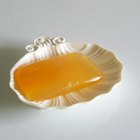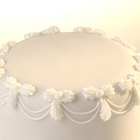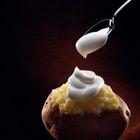
Whipping cream and half-and-half are both fresh, fluid dairy products that are processed before milk is homogenized, but they vary in their taste, texture and use. You can usually substitute whipping cream for half-and-half, especially if you dilute it with milk, but the results are mixed when half-and-half stands in for whipping cream.
Ingredients
The main difference between whipping cream and half-and-half lies in the ingredients. Whipping cream is the creamy layer that rises to the top of whole, non-homogenized milk. It contains between 35 and 38 percent milk fat. One cup of whipping cream has 821 calories, 88 grams of fat, and 70 percent of the recommended daily allowance of vitamin A. Half-and-half is a combination of cream and whole milk. It contains around 11 percent milk fat. Half-and-half has 315 calories, 28 grams of fat and 25 percent of the daily recommended allowance of calcium. It contains only 17 percent of the daily value of vitamin A.
Taste
Whipping cream has a slightly yellow appearance and a thick, creamy texture. It's almost thick enough to coat a spoon and it tastes velvety and rich. Half-and-half is thinner and paler in color. It tastes creamier than milk, but lacks the richness of cream.
Uses
When whipped, whipping cream doubles in volume, creating a light, fluffy product, suitable for using as a frosting or a topping. Half-and-half cannot be whipped, but it is ideal for adding a slightly creamy texture. Whipping cream works best in homemade ice cream, sauces, such as caramel or ganache, and creamy, savory dishes, such as fettucinne Alfredo, because it's less likely to curdle during cooking. Half-and-half is the best choice when you want a creamy flavor, without the cloying richness of whipping cream. Add it to coffee, tea or fruit or pour a bit over oatmeal or granola, along with some milk.
Storage
Both whipping cream and half-and-half are highly perishable. Store them in a refrigerator set at 40 degrees Fahrenheit and use them within five days of the use-by date on the package. Foods made with whipping cream and half-and-half should be refrigerated promptly. Don't add warm or lukewarm dairy products to a container containing cold whipping cream or half-and-half.
Related Articles

Recipe for How to Make Glycerin Soap ...

How to Get Half & Half to Thicken

Calories in a Tablespoon of Cream Cheese

The Difference Between Whipped Icing & ...

How to Fix Grainy Whipped Ganache

How to Add Irish Cream to Buttercream ...

How to Make a White Decorator Icing

What Happens if You Whip Condensed Milk?

How to Mix Whipped Cream Cheese & ...

Chocolate Martini: How Many Calories?

What Is a Good Substitute for ...
Does Sour Cream Go Bad if Unopened?

How to Make a Lip Mask for Extremely ...

What Is Clear Matrix Color Sync?

How to Make Aloe & Seaweed Lotion

How to Make Frosting Using All-Purpose ...

How to Use Gelatin to Thicken Frosting

What Is "Cultured Cream"?

What Is Cognac Leather?

Can I Thicken Ganache With Powdered ...
References
- The Kitchn: What's the Difference? Half-and-Half, Light Cream, Heavy Cream and Whipping Cream
- Joy of Baking: Cream
- Clemson University Extension: Safe Handling of Milk & Dairy Products
- Self: Nutrition Data: Cream, Fluid, Half and Half
- Self: Nutrition Data: Cream, Fluid, Heavy Whipping
- The Atomic Kitchen: Going Curdless: Tips to Avoid Curdling
Writer Bio
Julie Christensen is a food writer, caterer, and mom-chef. She's the creator of MarmaladeMom.org, dedicated to family fun and delicious food, and released a book titled "More Than Pot Roast: Fast, Fresh Slow Cooker Recipes."
Photo Credits
Eising/Photodisc/Getty Images